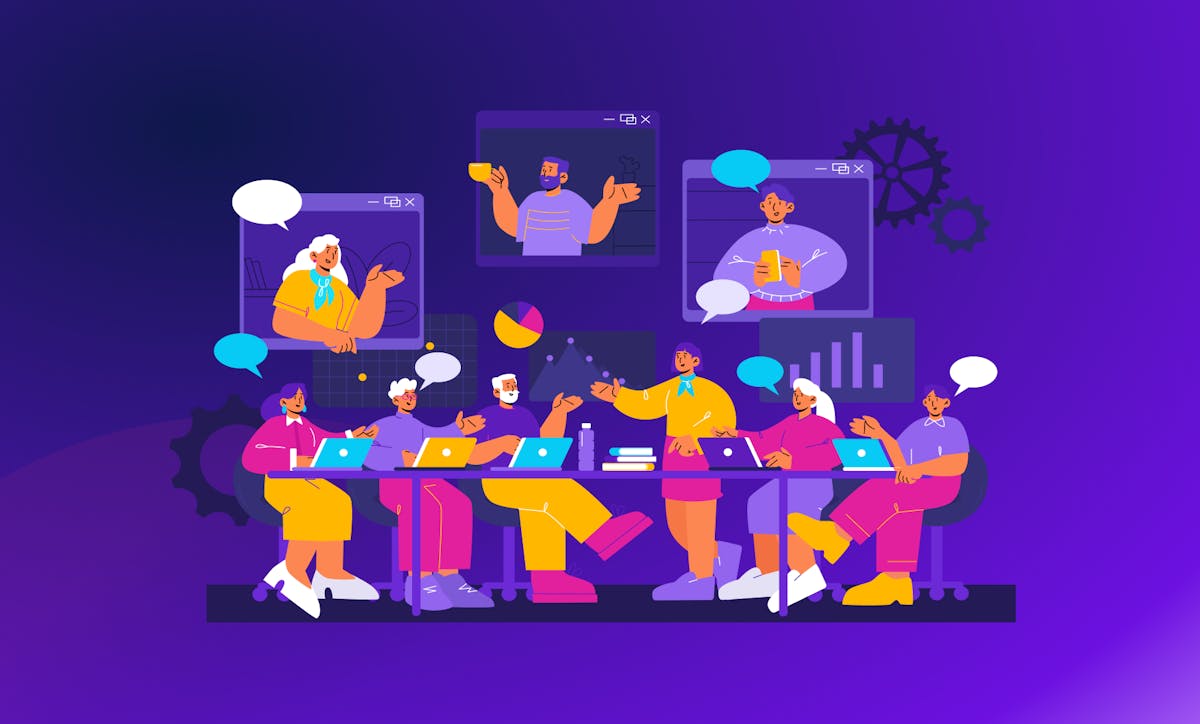The days of engineering teams huddled around a whiteboard are long gone.
The rise of remote and hybrid work models has reshaped how engineering teams operate in 2024 and beyond, creating a distributed workforce that thrives outside a traditional office space. This new normal shows a new way of working and presents a unique set of challenges and opportunities for engineering leaders.
As per the latest report we published on The State of Engineering Productivity, hybrid work arrangements lead to lower levels of personal productivity and below-average team productivity. Among survey respondents working in hybrid setups, 43% cited "context switching" and "too many meetings" as the top two reasons for decreased productivity. Further complicating matters, both remote and hybrid work environments often experience a lack of clarity and slower release processes, exacerbating productivity issues.
[ Download the full report here! ]
Under such findings, it is a challenge to build high-performing engineering teams at the behest of information gap, lack of coordination and trust within the teams, and ineffectiveness that percolates as a result of many other factors.
These challenges make it tough for engineering teams and leaders to find new ways to lead effectively. Remote and hybrid work setups, changing technology, and shifting talent needs require a fresh approach.
Engineering leaders must adapt to encourage innovation, teamwork, and top performance in teams across the globe.
Curious? What to do next?
We chatted with a panel of industry experts to gather their insights on steering remote and hybrid engineering teams.
Their unconventional advice is a goldmine for engineering managers and leaders, offering the right advice needed to navigate this ever-evolving landscape. Keep reading to discover their insights.
What Are The Advantages of A Remote/Hybrid Setup?
Amidst the shift from the traditional office setup, a variety of new possibilities emerge, such as:
- Global Talent Pool: Companies can now cast their nets wider, tapping into top-notch talent regardless of geographical boundaries. This diversity injects fresh perspectives and skills into the workforce.
- Enhanced Work-Life Balance: A remote or hybrid work set-up empowers engineers with more control over their schedules, fostering higher job satisfaction and potentially curbing turnover rates.
- Cost Savings: Embracing a remote or hybrid model enables companies to slash overhead expenses associated with maintaining physical office spaces, redirecting resources towards innovation and growth.
We recently had a conversation with Chakradar Raju, Senior Engineering Manager at Clari, and he says that any form of autonomy makes his engineering team much more productive. He shares, 'I rely and go by all the frameworks that already exist, but, I believe that developers perform at their best when they’re given freedom in whatever they like doing. That is something that has worked out for us so well, be it remote, hybrid or an in-office set-up.'
Chakradar’s team underwent a significant transition when Clari acquired Wingman. Recalling this period, he shares, “There were definitely a lot of changes. But collectively, we had everything streamlined. Changes were introduced gradually and in a way that everyone could accept. For example, we stuck with our usual ways, such as our hybrid work model, or using the same tools and operating in the same manner, for about a year or six months after the acquisition. This made the transitional period much smoother."
Sandeep, DevOps Lead at Razorpay flips the script on the traditional office model. While geographically close, his team at Razorpay thrives in a remote environment thanks to the power of collaboration tools like Slack and video calls. "We find these tools extremely while navigating a remote work set-up," Sandeep explains. "Working from home allows for a more focused, end-to-end workflow. We only venture into the office for specific events like hackathons, where the in-person environment fosters a different kind of collaboration."
This highlights how engineering teams have quickly adapted and gotten used to working from the location of their choice.
However, like every coin, there is another side. While the remote-hybrid model offers numerous advantages, it's not without its hurdles. Engineering leaders must confront and address these challenges to ensure the seamless operation of their teams.
Let's take a closer look at them.
What are the Disadvantages of A Remote/Hybrid Work Setup?
The many challenges of a remote/hybrid include:
- Communication and Collaboration: Maintaining clear communication and effective collaboration across geographically dispersed teams requires strategic planning and new tools.
- Building Team Culture: Fostering a strong team culture and sense of community can be more difficult in a remote setting.
- Maintaining Focus and Productivity: Remote work introduces distractions and requires self-discipline to stay focused and meet deadlines.
Our State of Engineering Report 2024 sheds more light on this. It shows that extreme setups—either fully remote or fully co-located—tend to score the highest in terms of both personal and team productivity. Interestingly, hybrid setups, which are the most common, prove to be the trickiest.
Creating a level playing field for remote and in-person team members is a real challenge. From managing impromptu meetings to getting face-time with managers, ensuring fairness can be tough.
Vipul, Engineering Manager at Bookmyshow, reflects on his experience with the hybrid setup, saying, "In my experience with the hybrid model, you typically hold synchronous standups on remote days. But when you’re in the office, it ideally makes more sense to skip standups because you can easily ask each other anything anytime due to the advantage of physical proximity."
When questioned about his preference for a full office setup, Vipul explains, "Initially, I was fond of working from the office, but I've come to accept the hybrid approach. Both options work well for me at present. However, I believe working from the office is essential for EMs and other senior leaders. The physical connection with your team fosters stronger bonds beyond just transactional interactions, which is crucial for team cohesion."
This highlights an important gap that is missed out in discussions about remote/hybrid work setups, which is that without the physical presence of a shared workspace, building and sustaining team camaraderie can prove challenging. Engineering managers must devise strategies to foster a sense of belonging and connection within their engineering teams, despite physical distance.
Best Practices to Lead Remote/Hybrid Engineering Teams in 2024
Recent trends show that flexibility and autonomy are pivotal in boosting developer satisfaction and productivity across various work setups. This movement extends beyond the simple desire to work from home or in-office; it underscores the need for individualized work styles and the integration of personal life with professional responsibilities.
As leaders of engineering teams in 2024 grapple with new work dynamics, the primary challenge is identifying strategies that maximize team effectiveness. So, how can they effectively adapt and excel with their engineering teams in remote/hybrid work environments?
Drawing from the strategies of our panel of industry experts, we’ve compiled proven strategies that foster a productive and cohesive workforce. Here are their few effective tips!
Best Practices to Lead Remote/Hybrid Engineering Teams in 2024
Recent trends show that flexibility and autonomy are pivotal in boosting developer satisfaction and productivity across various work setups. This movement extends beyond the simple desire to work from home or in-office; it underscores the need for individualized work styles and the integration of personal life with professional responsibilities.
As leaders of engineering teams in 2024 grapple with new work dynamics, the primary challenge is identifying strategies that maximize team effectiveness. So, how can they effectively adapt and excel with their engineering teams in remote/hybrid work environments?
Drawing from the strategies of our panel of industry experts, we’ve compiled proven strategies that foster a productive and cohesive workforce. Here are their few effective tips!
1. Regular In-Person Connections
Vipul underscores the significance of face-to-face interactions: "Consistent personal meetings, even if infrequent, are fundamental for nurturing strong bonds." These meetings reinforce trust and ensure each team member feels valued and integral, fostering a sense of unity regardless of geographical divides.
2. Empowering Teams with the Right Tools
Sandeep advocates for strategic technology use: "The right tools can revolutionize our work in remote settings." Equipping teams with effective technology enhances efficiency, reduces errors, and empowers employees to take ownership of their tasks, thereby achieving more in their roles.
3. Cultivating a Culture of Trust and Ownership
Chakradar explains the benefits of autonomy: "When team members make their own decisions, they become more committed and creative." This approach minimizes micromanagement and fosters an environment where constructive feedback and innovation thrive from trust and respect.
4. Strengthening Relationships Across Distances
Sandeep shares his strategy for team spirit: "We blend in-person meetings with virtual events to keep our team connected." These efforts are essential for building camaraderie and ensuring that all team members feel included, no matter where they are located.
5. Data-Driven Decision Making
Harish highlights the importance of data-driven engineering leadership in making informed decisions. Data plays a critical role in bridging the geographical gap between team members, and thereby allows leaders to identify trends, measure key metrics, and leverage insights to guide projects and team efforts towards success. This approach enables teams to prioritize high-impact projects efficiently, regardless of location.
6. Iterative Learning from Each Sprint
Vipul emphasizes the importance of continuous improvement: "Each sprint provides valuable lessons that can help you refine your methods and results." Regularly assessing and adapting strategies keeps teams agile and ready to tackle new challenges with refined tactics.
Beyond these strategies, implementing asynchronous stand-ups, simplifying processes, and enhancing communication channels are crucial for mastering the remote/hybrid model. However, each engineering team has unique strengths and challenges. What works for one might not work for another, so there is no one-size-fits-all solution. The key is to identify what works best for your team, learn what doesn’t, and then tailor your strategies accordingly.
If you're exploring options and seeking the optimal solution for your engineering teams, consider consulting with our productivity experts, and they will be more than just happy to help you find the right strategies that work for your engineering team.



